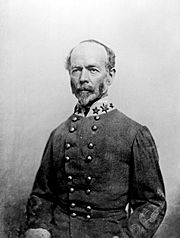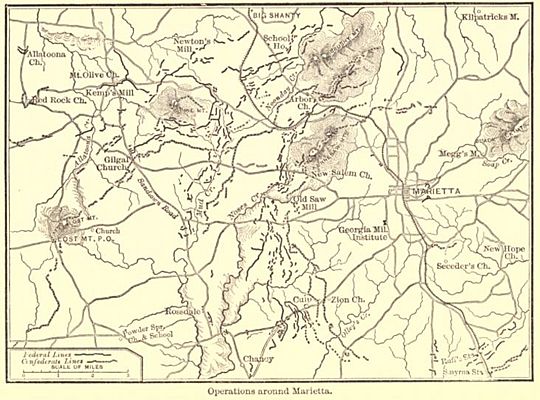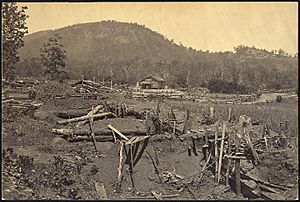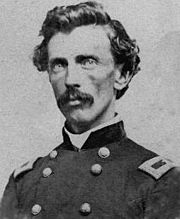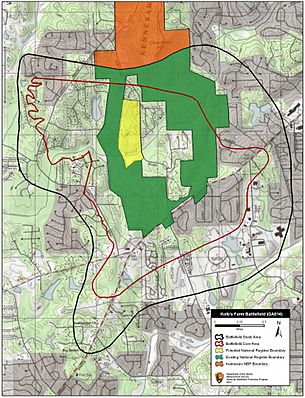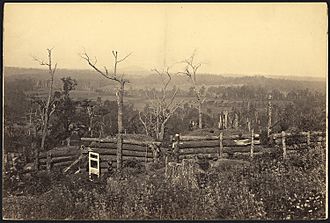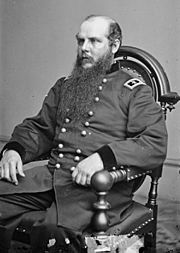Battle of Kolb's Farm facts for kids
Quick facts for kids Battle of Kolb's Farm |
|||||||
|---|---|---|---|---|---|---|---|
| Part of the American Civil War | |||||||
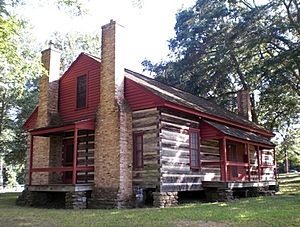 Kolb's Farmhouse as it appeared in 2015 |
|||||||
|
|||||||
| Belligerents | |||||||
| Commanders and leaders | |||||||
| John M. Schofield Joseph Hooker |
John B. Hood | ||||||
| Units involved | |||||||
| Army of the Ohio (XXIII Corps) XX Corps |
Hood's Corps | ||||||
| Strength | |||||||
| 14,000 | 11,000 | ||||||
| Casualties and losses | |||||||
| 250 | 1,500 | ||||||
The Battle of Kolb's Farm took place on June 22, 1864, during the American Civil War. It was part of the larger Atlanta campaign, where Union forces tried to capture Atlanta. In this battle, a Confederate army group led by John Bell Hood attacked parts of two Union army groups. These Union groups were commanded by Joseph Hooker and John Schofield.
Hood thought he saw a chance to defeat the Union soldiers in front of him. So, he ordered his troops to attack. However, Hooker's and Schofield's soldiers were in strong defensive positions. They successfully fought off Hood's attack, causing heavy losses for the Confederates.
After the battle, a disagreement happened between General Hooker and the main Union commander, William Tecumseh Sherman. This was because Hooker made an exaggerated claim about the battle. This argument made the already difficult relationship between the two generals even worse. Even though the Union won this battle, Sherman's plan to go around the Confederate army's side seemed to be blocked. Because he couldn't outsmart the Confederates, Sherman ordered a direct attack five days later.
Contents
Background to the Battle
Union Army's Goal
The main Union commander, Ulysses S. Grant, told General Sherman to "break up" the Confederate army. Sherman's goal was to move deep into enemy territory. He also needed to damage their resources used for the war. Sherman commanded parts of three large armies.
The Army of the Cumberland was led by George Henry Thomas. It included several smaller groups called corps. The Army of the Tennessee was commanded by James B. McPherson. The Army of the Ohio was led by John Schofield. Sherman started his campaign with nearly 100,000 soldiers.
Confederate Army's Defense
The Confederate Army of Tennessee was led by General Joseph E. Johnston. It had two main infantry (foot soldier) groups. These were led by William J. Hardee and John Bell Hood. There was also a cavalry (horse soldier) group. Later, another group led by Leonidas Polk joined them. General Polk was killed on June 14.
Johnston's army started the campaign with about 70,000 to 74,000 soldiers. They had already lost about 3,000 soldiers in earlier fights.
Moving Towards Kennesaw
The Atlanta campaign started on May 7, 1864. Sherman's forces began to advance. Sherman often tried to go around Johnston's defenses. This strategy led to several battles and skirmishes.
After the Battle of Rocky Face Ridge, Johnston pulled his troops back. The Battle of Resaca happened next, and Johnston retreated again. After a small fight at Adairsville, Johnston tried to trap Sherman's forces. But his plan failed, and the Confederates retreated again on May 20.
Sherman then tried to go around the strong Confederate defenses at Allatoona Pass. This led to more fighting in late May, known as the Battle of Dallas. Union forces then moved east. This forced Johnston to retreat once more. By mid-June, after more fighting, Johnston's army fell back to Kennesaw Mountain.
Kennesaw Mountain Defenses
Kennesaw Mountain was a very important part of the Confederate defenses. The mountain ridge runs from northeast to southwest. It has three main peaks: Big Kennesaw, Little Kennesaw, and Pigeon Hill. From Big Kennesaw, Confederate soldiers could see any Union movements during the day. Kennesaw Mountain was a very strong position.
Hood's Confederate group was on the right side of the defenses, east of Kennesaw Mountain. Another group held the center of the mountain. Hardee's group held the left side. His troops were behind Noses Creek, which was swollen from heavy rains. The Confederate soldiers defended a front about 7 miles long.
On June 19, Sherman thought the Confederates had retreated further. But he soon realized he was wrong. Union forces moved forward. Hooker's group was able to cross Noses Creek. Schofield's group also reached Noses Creek but did not cross it yet. Union cannons fired at Pigeon Hill, causing some Confederate casualties.
On June 20, Sherman began to move his right side further south. More Union troops crossed Noses Creek. They captured some hills, but Confederates recaptured one of them. It rained constantly, causing many soldiers to get sick.
The Battle of Kolb's Farm
Moving into Position on June 21
On June 21, Sherman's army kept moving its right side. This allowed Hooker's group to move further to the right. Hooker's soldiers pushed forward. They took over some hills near Kolb's Farm. Schofield's group also crossed Noses Creek and connected with Hooker's right side.
General Johnston noticed Sherman's movements. He realized his own lines were stretched thin. So, Johnston decided to move Hood's group from his right side to his left side. This was to counter Sherman's move. Johnston knew this was risky, but he felt it was his only choice besides retreating. By the evening of June 21, Hood's group had moved to the Powder Springs road, west of Marietta.
The Attack on June 22
June 22 was a clear day. Sherman decided to make a big effort to force Johnston to retreat. He ordered Hooker to move his group east toward Marietta. Sherman also told Schofield to advance along the Powder Springs-Marietta road.
Early in the afternoon, Hooker's soldiers moved forward. Soon, Union scouts reported that Confederates were forming for an attack. This news made Hooker order his troops to dig in and build defenses. They created a strong line of trenches. Schofield's soldiers also fortified their positions nearby.
Hooker's group had already suffered many casualties in the campaign. His soldiers were ready for a fight. They sent out scouting parties. These scouts saw large numbers of Confederates gathering for an attack. They quickly reported this information. Hooker asked for reinforcements, saying the "whole rebel army" was in front of him. However, General Thomas, who came to check, thought the threat was exaggerated. He believed Hooker's line was strong enough.
Around 5 p.m., Hood's Confederate attack began. Hood believed the Union soldiers were marching and not ready for a fight. He thought his attack would be a powerful surprise.
Confederate soldiers advanced through thick woods. They were met with heavy rifle fire from the Union lines. One Union regiment, the 14th Kentucky, reported finding 69 dead Confederates in front of their position. Union artillery also fired canister shot (a type of cannon ammunition filled with small balls, like a giant shotgun). This drove back the Confederates.
North of the road, other Confederate troops advanced into open fields. They were hit hard by Union artillery from a nearby hill. These cannons fired continuously. Confederate soldiers tried to find cover but were trapped by the intense fire.
Another Confederate group tried to attack. But they also came under heavy artillery fire. Many soldiers fled or took cover. Some faced marshy ground, which made their advance difficult. They couldn't cross a boggy creek under fire. Union accounts say that this part of the attack was stopped by artillery alone.
Aftermath of the Battle
Battle Losses
General Johnston admitted losing 1,000 soldiers in the battle. Union losses were much smaller, about 250 soldiers. Historians estimate that Hood's attack cost his Confederate group about 1,500 soldiers killed, wounded, or missing. This battle was a very one-sided defeat for the Confederates. The Union forces had about 14,000 soldiers, while Hood had about 11,000.
The Sherman-Hooker Disagreement
Sherman was not near the battle when it happened. He received a message from Hooker saying they had "repulsed two heavy attacks." Hooker also said he was worried about his right side and that "three entire corps" were in front of them. Sherman was confused. He knew Schofield's group was supposed to be on Hooker's right. He also doubted there could be three Confederate corps there.
Sherman later wrote in his memoirs that he met with Hooker and Schofield. He said Schofield was angry about Hooker's message. Sherman also said he scolded Hooker for claiming he faced three Confederate corps. However, later accounts suggest Sherman might have remembered things differently. Schofield himself said he wasn't angry and that Sherman might have misunderstood.
While Hooker's claim of three corps was an exaggeration, there was some truth to it. Hood's entire group was there, and parts of other Confederate groups were nearby. Despite the misunderstanding, Hooker performed well as a leader during the battle.
This incident further damaged the relationship between Hooker and Sherman. Hooker already felt that Sherman favored other generals. Later, when a senior commander was killed, Hooker expected to take his place. But Sherman chose another general instead. Hooker felt insulted and resigned from his command.
Sherman's Frustration
The day after the battle, Hood's group had dug in. It was clear that attacking them directly would be a bad idea. Sherman tried to find another way to go around the Confederate left side. But his generals reported that their lines were already stretched too far.
Sherman was frustrated. He sent a message saying, "The whole country is one vast fort." He meant that the Confederates had strong defenses everywhere. Sherman had three main choices: attack Johnston's right side, slowly wear down the Confederate defenses, or make a direct frontal assault.
He decided against attacking the right side. He was worried about his supply lines. He also didn't want a stalemate, as his mission was to keep Johnston's army busy. So, Sherman chose to make a direct frontal attack. He believed that even though the Confederate lines were long, they must be weak somewhere. This decision led to the Battle of Kennesaw Mountain on June 27. In that battle, Union attacks were pushed back with many casualties.
Battlefield Condition Today
Much of the Kolb's Farm battlefield has changed over time. However, some important parts remain. These include the Kolb farmhouse, the family cemetery, and Ward Creek. The hills used by the Union forces during the battle are also still there. These areas are now protected within the Kennesaw Mountain National Battlefield Park. New homes and buildings have been built around the park.


